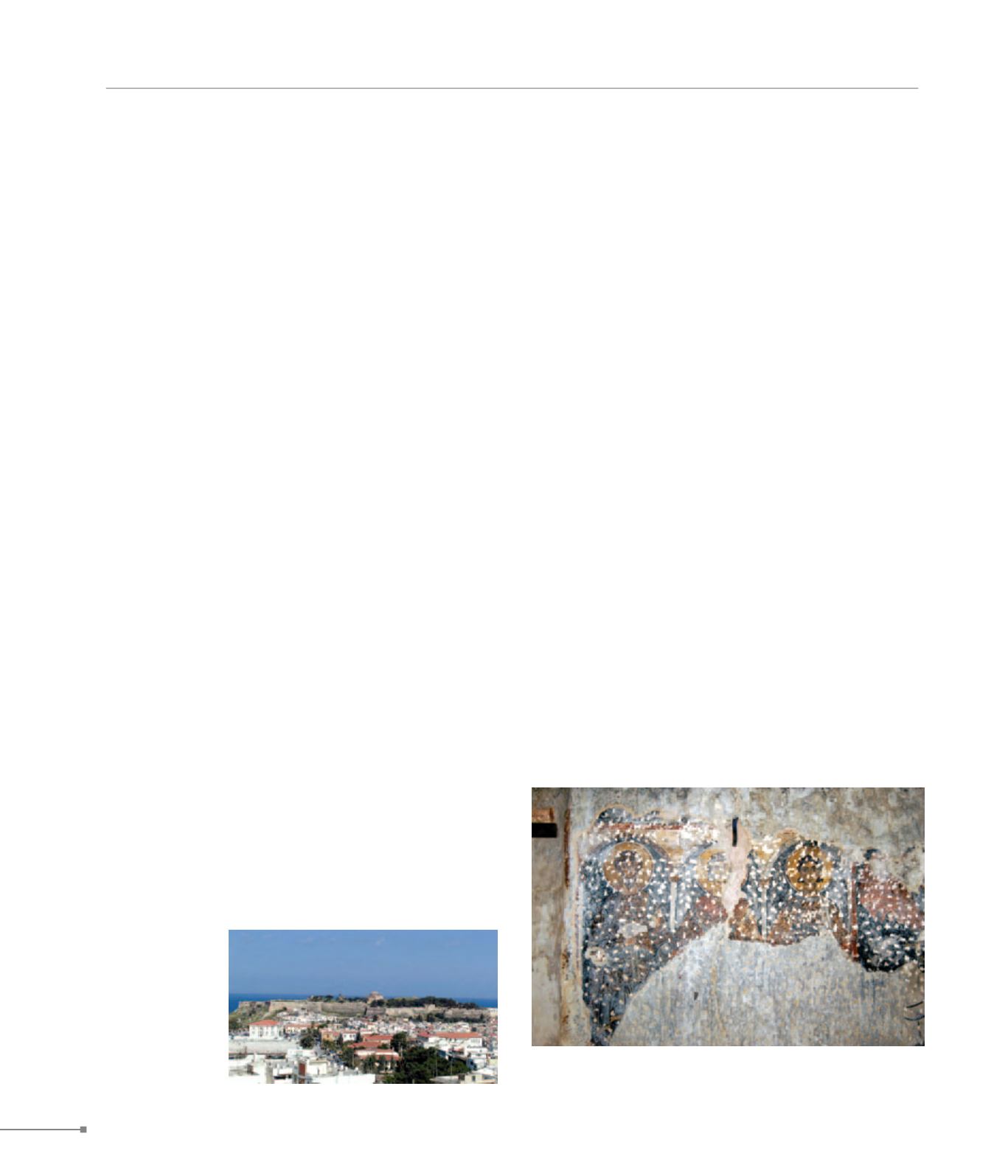
Monopari.
Preveli Monastery.
CRETE
258
396. Preveli monastery, Saint George at Ksylomachairi, wall painting
(Μονή Πρέβελη, Άγιος Γεώργιος στο Ξυλομαχαίρι, τοιχογραφία)
394. Rethymno,
Fortezza (Ρέθυμνο,
Φορτέτζα)
393.
Monopari.
Monopari is a large fortress NW of the Monopari village men-
tioned as Bonriparo in Venetian sources and as Kastelos by
the local inhabitants (named after the neighbouring village
with the same name). It borders the inland road connecting
Rethymno with Chania, it has visual contact with the fortresses
of Syvritos and Kyriakoselia, and controls a wide area inland.
It was built in the Mid-Byzantine period and includes towers,
curtain walls, and a bulwark, fortifying the vulnerable N side,
since the other two sides are mostly inaccessible. Within the
walls is a large barrel-vaulted cistern, and ruins of a rectangu-
lar structure and of houses. In the nearby Ano Malaki village
an Early Christian basilica has been discovered, while nearby
stands the unique single-nave church of Aghia Marina, its E
section covered with ellipsoidal calotte.
394.
Rethymno.
The city of Rethymno first appeared in the Hellenistic years;
it was named Rithymna and had a citadel on the site of the
Fortezza fortress. After the Arab occupation the city still ex-
isted and was declared capital of Rethymno region by the
Venetians in the 13th c. and Latin see of Rethymno in the 15th
c. The small, fortified city stretched around the harbour. In
the 14th c. it started to expand outside the walls and its new
fortifications are attested by a larger enclosure. In the 16th
c., within the framework of an extensive Cretan defence plan,
the fortifications were built according to the modern bastion
system. In the second half of the century the robust Fortezza
fortress was constructed on Paliokastro hill. Very few are the
remains from the city’s earlier building phases.
395.
Aghios Vasileios.
The church of Saint John Prodromos, chapel of the small,
neighbouring Sinaitic monastery of Speliotissa, includes wall-
paintings with rare scenes from the life of the saint, accom-
panied by a founder’s inscription mentioning the year 1291,
the founder’s name Nikolaos Tziakontopoulos, and the Byz-
antine Emperor Andronicus II Palaeologus. The style of the
wall-paintings is archaic.
396.
Preveli Monastery.
In the environs of the later Preveli monastery, at the site of
which there used to be a decorated church, survives a group
of small churches. At the deserted Ksylomachairi site, near the
monastery, is the barrel-vaulted, single-nave church of Saint
George. The original church that was built and painted in the
mid-13th c. was expanded to the W and was painted again.
On the original layer created in accordance with 12th c. tradi-
tion, military officers are discernible. The second layer dates
from the mid-14th c. The barrel-vaulted church of Aghia Pho-
teine, E of the monastery, features frescoes of the late 14th
c. The small church of Saint John Prodromos is similar, with
wall-paintings of the first half of the 15th c. At the inaccessible
Xeroritissa site lies the ruined church of Panagia, with decora-
tion of the mid-14th c.
cholas, featuring sculpted panels in secondary use. At Kato
Valsamonero the barrel-vaulted, single-nave church of Saint
John preserves frescoes in two layers, the original work of a
folk craftsman of the late 13th c. and the later layer from the
first half of the 14th c.


